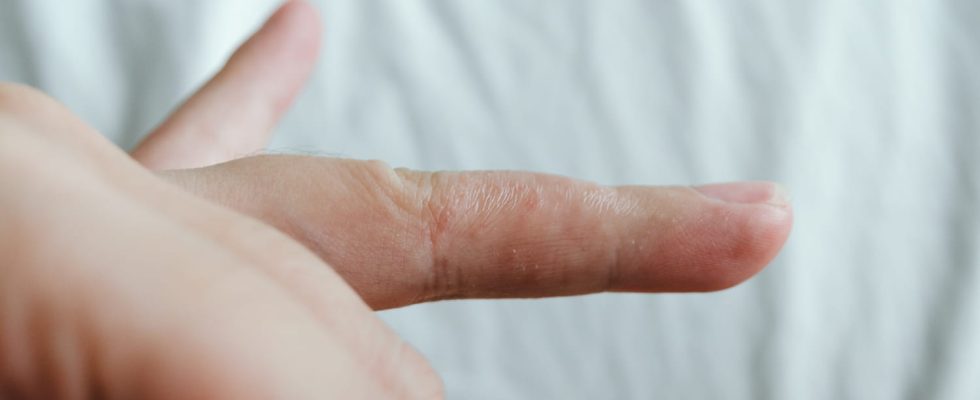Dyshidrosis (or dyshidrosis) is a type of eczema that affects the hands and feet and is characterized by vesicles or small bubbles on the skin. Excessive sweating is an aggravating factor.
There dyshidrosis is a guy eczema which affects the men that women. She is, however, more common in young adults and adolescents. This eczema is most often chronic and recurring and in fact has a significant impact on the quality of life (due to the itching and character displaying disease).
Dyshidrosis (also spelled “dishidrosis” or “dyshidrosis”, and sometimes called dishhidrotic eczema)”has a clinical and visual definition: it is the presence of any small blisters or bubbles on the hands and/or feet“, immediately informs Dr Haudrey Assier, dermatologist, allergist at the Henri Mondor hospital (Créteil). This skin condition is not not contagious.
“I’origin of dyshidrosis is most often unknownthat is to say that we often do not know its cause“, says Dr. Haudrey Assier. However, it appears that dyshidrosis occurs more often in hot weather and some flare-ups can be triggered by the emotional stress. The genetic predisposition, on the other hand, remains weak. There are also contributing factors: sweating and hyperhidrosis (excessive sweating): indeed, “atopic people are slightly more affected by dyshidrosis“, specifies the dermatologist. Certain products can be considered as aggravating factors of dyshidrosis: the smoking, aspirin, certain non-steroidal anti-inflammatory drugs and analgesics, estrogen-progestins… However, it is necessary look for cases that may have a cause, that is to say a factor that can be treated. So it can be a mycosis. In this case, a sample is taken to confirm the diagnosis and treat effectively. Another cause is allergic eczema. It could be an allergy to gloves or shoes, to hand-touching cosmetics, or to work-related chemicals. If this origin is suspected, tests will have to be done.
Dyshidrosis is mainly manifested by small blisters or bubbles on the palms of the hands, soles of the feet, of the lateral surfaces of the fingers and toes, accompanied by pruritus (itching) or a burning sensation. “Pruritus is very annoying, can be insomnia“says the dermatologist.
The effective treatment for dyshidrosis is the application of a cortisone cream. In addition, you must always keep the affected area dry: dry your feet well, for example (especially between the toes) after showering, avoid wearing shoes that increase perspiration…
To treat this condition,we mainly use cortisone creams as with other inflammatory skin diseases“, specifies Dr. Haudrey Assier. “The palms of the feet and the soles of the hands are made up of thick skin too. very little cortisone enters the body” adds the dermatologist. And to advise “when the dyshidrosis is stubborn, it is advisable to apply the corticosteroid cream under occlusion“. It is put the area with the cream under cellophane or plastic gloves. “As it is an often recurrent condition, it is important to treat yourself at the first signs “.”In case of annoying bubbles it is possible to pierce them after disinfection and do not forget to continue the cortisone cream“, recommends the dermatologist. More rarely and in case of failure, topical corticosteroids may be offered: immunomodulatory cream (tacrolimus), UV therapy, or even corticosteroid tablets. Superinfections of dyshidrosis are rare and, if confirmed, they are treated with antibiotic tablets.
Fighting against perspiration is important, sweat being a contributing factor. “People with hyperhidrosis (excessive sweating) can use aluminum based creams to reduce perspiration of the feet and hands. Inophoresis can also be used”, says Dr. Haudrey Assier. Quitting smoking is also recommended (1). Finally, contact with irritating products should be eliminated (wear gloves in risky situations, change them often),avoid humidity (good non-wet shoesif possible alternated every other day, gloves changed often and adapted to the profession) and to use soft hygiene products.
Thanks to Dr Haudrey Assier, dermatologist, allergist at Henri Mondor Hospital (Créteil).
(1) Giordano-Labadie. News in the treatment of hand dermatitis, p.115-23. in Progress in dermato-allergology, GERDA 2001, John Libbey Eurotext Ed.
